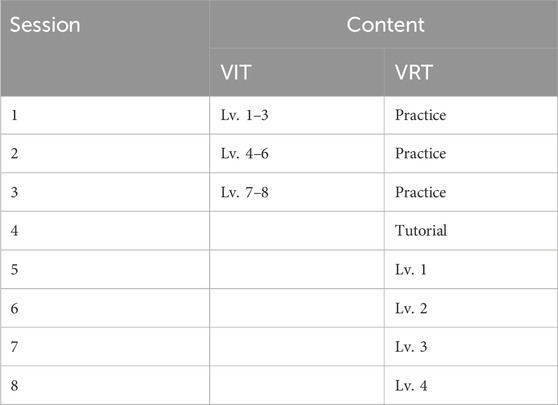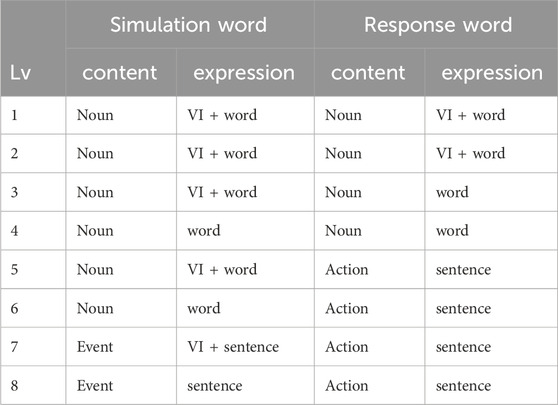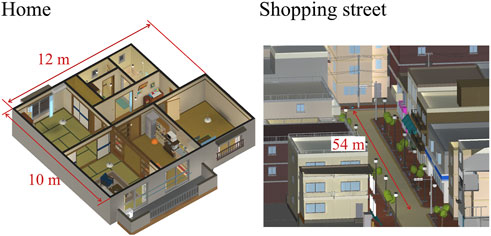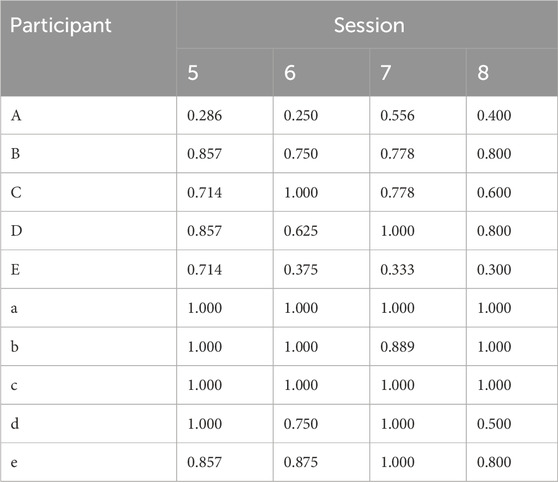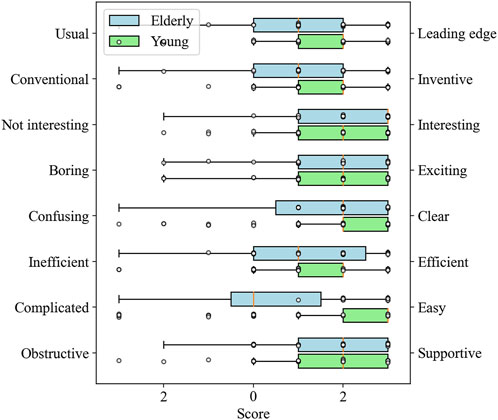- 1Faculty of Design and Engineering, Kagawa University, Takamatsu, Japan
- 2Faculty of Humanities, Nagasaki Junshin Catholic University, Nagasaki, Japan
- 3Clinical Research Center, Saga University Hospital, Saga, Japan
- 4Department of Clinical Psychology, Graduate School of Education, Hyogo University of Teacher Education, Kobe, Japan
- 5Department of Psychiatry, Graduate School of Medicine, Kyoto University, Kyoto, Japan
Prospective memory (PM), defining the currently conceived intention of a future action, is crucial for daily functioning, particularly in aging populations. This study develops and validates a virtual reality prospective memory training (VR–PMT) system that integrates visual imagery training (VIT) and virtual reality training (VRT) to enhance the PM abilities of users. The framework is designed to progressively challenge users by simulating real-life PM tasks in a controlled VR environment. The VIT component is designed to improve the generation and utilization of visual imagery by users, while the VRT component provides PM tasks based on time and event cues within a virtual environment. The framework was evaluated on ten healthy adults (university students and elderly participants) over 9 weeks. During the initial session, the baseline PM abilities of the participants were assessed using the memory for intentions screening test (MIST). The subsequent sessions alternated between VIT and VRT with increasing task complexity. The MIST scores were significantly positively correlated with task achievement, confirming the efficacy of the system. Imagery abilities were also strongly correlated with task performance, underscoring the importance of visual imagery in PM training. Usability and user experiences, evaluated on the Jikaku-sho Shirabe questionnaire and the user experience questionnaire, indicated an overall positive user experience but higher fatigue levels in elderly participants. This study demonstrates that the VR–PMT system effectively trains and assesses PM abilities by integrating VIT and VRT, supporting its potential for broader applications in clinical settings.
1 Introduction
Prospective memory (PM), defining the ability to remember and perform an intended action at a specific future time or in a particular future context (Martin et al., 2003), is crucial in the daily lives of humans. For example, PM initiates actions such as turning off the stove to prevent a possible fire or taking medication at a specified time to avoid potential health consequences. PM is important for maintaining the quality of life (Zogg et al., 2012; Woods et al., 2012; Woods et al., 2014; Woods et al., 2015; Sheppard et al., 2020) and for independently performing daily activities (Zöllig et al., 2007). PM failure is a serious problem for family members and caregivers, who are required to remember the schedule of the affected person. Previous studies have indicated that PM ability declines with age. In particular, older adults perform less well on PM tasks than young adults (Henry et al., 2004; Kvavilashvili et al., 2009; Koo et al., 2021). PM ability is also altered by mental disorders such as brain injuries, schizophrenia, and Alzheimer’s disease (Wang et al., 2009; Berg et al., 2012; Raskin et al., 2020).
Psychological interventions targeting PM impairment, such as PM training, have been extensively studied. Such interventions have proven their effectiveness in various populations, including older adults and individuals affected by various diseases (Jones et al., 2021; Hering et al., 2014). As highlighted by Raskin, visual imagery training (VIT), a technique for visualization based on a given word, is an important self-supporting strategy that can improve PM deficits (Raskin et al., 2019). Umeda et al. (2006) attempted to improve PM impairment in brain injury patients through training on Mini-day tasks. They instructed participants to visualize themselves performing actions in real-life scenarios while remembering the tasks, thereby connecting the intervention to everyday situations. Mathews et al. (2016) reported that PM impairment in brain injury patients was improved after cognitive training incorporating virtual reality (VR) technology that combines strategy acquisition with practical application. Training based on visual imagery strategies (the internal strategy approach) can be enhanced through VR technology. Moreover, head-mounted displays can resolve a major challenge in conventional PM studies, namely, minimizing the environmental differences between laboratory and real-life settings.
Many training methods that aim to improve cognitive functions are limited by the differences between real-world environments and laboratory settings. Several studies (Valmaggia et al., 2016; Rus-Calafell et al., 2018) have indicated that VR methodologies can recreate social events within a controlled laboratory environment. As traditional training methods related to PM cannot fully replicate the PM scenarios encountered in daily life, their training effectiveness is limited. In contrast, VR technology can recreate realistic environments, allows users to immerse themselves in the training process. VR can also simulate daily-life scenarios within a laboratory setting, improving the effectiveness of PM training. Previous VR-based PM studies (Huang et al., 2022; Hogan et al., 2023) have not described the task protocols and environmental settings in detail and have instead focused primarily on improving PM abilities. Our study addresses this gap by employing a multi-level task design that integrates several types of tasks for prospective memory, and by providing a comprehensive description of its implementation.
In this study, we propose and implement a framework to develop a VR-based training system for enhancing PM skills. This framework comprises task types, difficulty levels, and realistic training environments to simulate daily PM challenges. The effectiveness of the proposed framework is evaluated by implementing the training system and conducting preliminary validation with healthy adults who do not suffer from clinical dementia to analyze the system’s capacity to accurately reflect PM abilities. If properly designed, the system should indicate task achievement rates corresponding to the PM capabilities of participants.
Training and evaluating PM abilities is an inherently challenging task. Several tests (Radford et al., 2011; Wilson et al., 2005; Raskin et al., 2010) have been established for assessing PM capabilities, but the evaluated tasks are limited to simple and abstract activities. For instance, the Cambridge Prospective Memory Test (CAMPROMPT) provides six pen-and-paper tasks for PM assessment. As PM is intricately linked to real-life environments and specific times of the day, abstract tasks are insufficient for a comprehensive evaluation. Recall can be aided by the passage of time (e.g., by the approach of evening, reminding the individual that shopping time is 5 p.m.) and environmental cues (e.g., a telephone in view that reminds the individual of their intention to make a phone call). By simulating real-world environments and times, VR-created environments offer highly interactive modalities and can achieve high ecological validity (Kourtesis et al., 2020; Kourtesis et al., 2021). Various VR-based evaluations of PM in patients with brain injuries have demonstrated the potential for VR in creating realistic and effective assessment environments (Brooks et al., 2004; Knight and Titov, 2009).
PM requires both remembering and recall abilities. Few specialist training methods for PM can simulate real-life situations, although several traditional training methods can create these conditions. In Virtual Week (Rendell and Henry, 2009; Mioni et al., 2015), a board game-style training, the participants move around the board using dice, select plausible daily activities, and must remember and complete PM tasks. Mini-day task (Umeda et al., 2006) uses cards with schedule-related contents and times (e.g., “10:00; buy a ticket at Hakata Station”). The trainees visualize and memorize the schedules written on the cards and then execute the schedules on an accelerated timeline. When applied to training methods such as Virtual Week and Mini-day tasks, VR can simulate complex and dynamic environments, providing participants with more realistic situations. Yip and Man (2013) developed a training program using desktop-based VR. This system provides participants with realistic situations, but the tasks are limited to shopping. Mathews et al. (2016) developed a system with more complex and realistic tasks. This system adopts and extends Virtual Week, along with Mini-day and Mathews’ system. The two latter methods provide no practice for imagery and do not account for differences among individuals’ abilities to control their visual imagery; instead, imagery generation is left to the individuals’ discretion. As visual imagery and associations are challenging to some individuals (Miura et al., 2008), visual imagery strategies can be effectively harnessed only when tailored to individual needs. Therefore, the present study incorporates training into visual imagery strategies. VR is advantageous for visual imagery because it can display a wide variety of images. Therefore, VR is ideally suited for incorporating an imagery strategy into a training system. Mathews’ system (Mathews et al., 2016) integrates visual imagery strategies with VR training in realistic situations, making it particularly effective for enhancing PM. The system (Mathews et al., 2016) is structured into two phases. The first phase focuses on imagery training and encourages participants to visualize themselves performing tasks; this technique is known to enhance PM. In the second phase, participants apply these visualization skills within a realistic VR environment, bridging internal strategy training with practical application. This two-phase approach that combines visualization and realistic simulation adopts Mathews’ integrated method for PM training. Among many suggested subtypes of PM tasks (Shum et al., 2002; Guajardo and Best, 2000; Park et al., 1997), time- and event-based tasks are the most suitable for clinical tests and are most commonly adopted (Park et al., 1997; Kliegel et al., 2001; Hicks et al., 2005). Time-based tasks require the individual to remember and perform an action at a specific time or after a certain period of time. A typical time-based task is meeting somebody at a restaurant at 19:00. In contrast, event-based tasks is one triggered by another event, such as taking medication after meals. Virtual Week (Rendell and Henry, 2009) sets regular and irregular tasks as rule-based and non-rule-based tasks, respectively. Both types of tasks are required in VR training. An effective training system must also provide individuals with purposeful PM tasks that they will likely encounter in daily life. VR-based PM training often focuses on time/event-based tasks (Henry et al., 2004; Kvavilashvili et al., 2009; Koo et al., 2021).
This study aims to design a VR framework that integrates time-based/event-based and regular/irregular tasks to capture the complexity of real-life scenarios and reflect PM abilities. Daily life usually includes regular schedules (e.g., taking medication after meals) and irregular schedules (e.g., going to the bank). Regular tasks establish a routine, reinforcing memory through repetition. In contrast, an irregular task, such as collecting a suit from the dry cleaners while shopping, requires flexibility and the ability to remember less frequently performed tasks. By including both types of tasks, the training system can better simulate the variety of PM challenges encountered in daily life, thus providing a more comprehensive training experience. Rose et al. (2010) and Shelton et al. (2016) involved both PM task types (regular/irregular) and PM cue types (time/event) in Virtual Week, demonstrating the importance of considering multiple dimensions of PM. Therefore, a VR-based training system must encompass both regular and irregular tasks, along with time-based and event-based tasks, to ensure well-rounded and effective training tasks.
2 Materials and methods
2.1 Design of framework
The VR–PMT program integrates VIT for PM task support and virtual reality training (VRT) for simulating a realistic environment. The VIT is designed to enhance the trainee’s ability to generate and use visual imagery, which is an important skill in PM. The training is implemented by VIT followed by VRT. This subsection defines the design requirements of the VIT and VRT programs, particularly focusing on the design of the VRT program.
2.1.1 Visual imagery training
The VIT program integrates methodologies proposed by Mathews et al. (2016) and Raskin et al. (2019) to optimize the effectiveness of PM training using visual imagery. This program is implemented prior to the VRT phase to ensure that participants develop sufficient visual imagery skills before engaging in VR-based PM tasks. The tasks in the VIT program are designed such that they become increasingly relevant in daily life as training progresses, thereby enabling participants to apply strategies used in these tasks in virtual and real-world contexts. The VIT program is designed to help participants acquire internal strategies that use visual imagery to enhance memory encoding and retrieval, thereby reducing PM failures. The program employs a multilevel approach comprising eight stages that gradually increase in complexity, offering participants repeated opportunities to practice and refine their memory skills. The levels progress by shifting from image-based to text-based training. In the initial stage, participants are presented with two noun words in the textual and pictorial forms, along with a linking image that visually associates the two concepts (e.g., an image connecting “milk” and “pumpkin,” where milk is poured into a hollowed-out pumpkin). In the next stage, the linking image is omitted and participants are required to generate the association between the two words independently. As training progresses, one of the words is exclusively replaced with text. In a more advanced stage, both words are replaced with text. In later stages (Levels 5 and beyond), training shifts to more complex tasks wherein one of the words is replaced with an action-based phrase (e.g., “egg–making an omelet”) and time- and event-based cues that prompt participants to generate visual imagery for real-world scenarios are incorporated (e.g., “pass supermarket–buy strawberries”).
2.1.2 VRT
In VRT, users must remember to perform PM tasks at specific times in relation to certain places or events. A foundational function of VRT is to incorporate realistic place and time elements. To effectively simulate real-life scenarios, VRT must have at least two settings, such as a home environment and an outdoor area, that mirror daily living conditions. The architecture and objects in the virtual environment should reflect familiar surroundings.
For the effective execution of PM tasks, users must have access to the current simulated time and should be able to track the passage of time as they would in real life. Moreover, simulating an entire day in real time would impose an unrealistic cognitive load on users. Therefore, the virtual environment accelerates time to ensure efficient and manageable training. Previous studies (Umeda et al., 2006; Rendell and Craik, 2000a; Mathews et al., 2016) have demonstrated the effectiveness of using simulated time in similar training scenarios, enabling users to experience a condensed, yet comprehensive, daily routine. In VRT, users simulate their daily lives multiple times. The tasks in each simulation are designed and categorized by cue type (time-based or event-based) and by frequency (regular or irregular). PM tasks depend on external cues that stimulate recall. Event-based tasks use cues (e.g., meeting someone or having lunch) to trigger action recalls, while time-based tasks rely on specific times and the passage of time. During a time-based task, the user must check the time and act accordingly. Regular tasks are repeated daily, while irregular tasks are performed once only. Combining both types provides tasks that reflect real-life diversity. To help users gradually adapt to real-life situations, the task difficulty increases with each training session. Previous studies have shown that time-based tasks are more challenging than event-based tasks (Hicks et al., 2005; Mathews et al., 2016); moreover, irregular tasks are more challenging than regular ones (Rose et al., 2010; Shelton et al., 2016). Clearly, tasks combining time-based and irregular elements are the most difficult, while those combining regular and event-based elements are the easiest.
VRT also requires distractor tasks to mimic real life in the virtual environment. Users engage in distractor tasks when not performing scheduled PM tasks, substituting actions typically performed in daily life, such as housework or work-related activities. Distractor tasks prevent users from rehearsing their PM tasks, promoting more natural recall of their intended actions. Additionally, distractor tasks should be enjoyable to engage users in the training experience. Each area in the training environment, such as the house or shopping area, should have at least one distractor task point. Including at least one distractor task point in each area of the training environment, such as the house or shopping area, ensures that the virtual environment reflects the daily-life conditions. In real life, people are often engaged in various activities, such as housework and browsing in a store, while waiting for the right time or event to execute the PM tasks. By integrating distractor tasks into each area, the system helps simulate a natural multitasking environment, fostering better task relevance. The distractor tasks should be enjoyable such that users engage in the training experience and prevent themselves from rehearsing their PM tasks, promoting a more natural recall of their intended actions.
In the errorless learning method, users learn the correct responses at the beginning and repeatedly practice the correct responses, thereby minimizing their errors during the learning process (Sohlberg et al., 2005). According to Sohlberg, errorless learning is primarily intended to reduce errors during the learning phase. The aim of VRT is the perceived successful completion of each task. If users forget to execute a time-based task, the system displays a message reminding them of the task without instilling a sense of failure. The message might read “Oops, it is time for your scheduled task.” If users perform an incorrect action of the intended task, they are alerted with a simple sound.
To effectively simulate real-life situations in VRT, users must familiarize themselves with the system operations and VR environment spatial layout; this process often requires sufficient time as it involves extensive pre-instruction or memorization of the map layout. To reduce the time required for these activities, the system provides participants with tasks for VIT within the VRT environment. This integration helps them familiarize with the system operations and acclimatize to the map layout. In addition, practicing regular and event-based PM tasks within the same environment after VIT further facilitates participants’ adaptation to VRT. This approach minimizes the cognitive demands during VRT sessions by gradually building familiarity and reducing the effort required to remember task-related information.
2.2 Implementation
The VR–PMT system is implemented under the framework designed to integrate VIT and VRT programs. This section details the hardware and software setups of both programs.
2.2.1 Hardware
The VR–PMT system provides an immersive experience through a VR headset with controllers. For this purpose, Meta Quest 2 was chosen for its high resolution, comfortable fit, and reliable tracking system. A user receives immersive visual and auditory feedback and interact within the VR environment using hand controllers, mimicking human–environment interactions in the real world. The Meta Quest 2 headset is connected to an Alienware m15 R4 PC equipped with an Intel i9 processor, 32GB RAM, and an NVIDIA GTX 3080 GPU that records the behavior logs and task achievement, ensuring smooth operation and rendering of virtual environments.
2.2.2 Program schedules and software setup
Each 1-h training session was conducted once weekly. To ensure effective and safe training, each session was supervised by an assistant with multiple roles: providing support, ensuring smooth operation of the VR system, and helping the participants with any difficulties encountered during the training. Each session of the experimental schedule focused on different aspects of VIT and VRT (see Table 1 for the contents of each session). In Sessions one to three, the participants engaged in the VIT program and practiced the VRT program. Session 4 was dedicated to a tutorial in which the assistant re-iterated the VRT program and demonstrated the regular tasks to be performed in the VRT program. In Sessions five to eight, the participants fully engaged in the VRT program, applying the skills learned in previous sessions.
The integration of VIT and VRT into the VR–PMT system ensures a seamless transition between the two phases, enhancing the overall training efficacy. During the first session, participants received explanations about PM and visual imagery strategies and practiced operating the VR–PMT system. The participants first engaged in VIT and subsequently practiced operations in VRT. In the second session, participants continued with VIT and practiced the necessary background tasks of VRT. The third and fourth sessions provided the participants with further VRT practice and a tutorial on the VRT phase, respectively. During the tutorial, the participants listened to detailed instructions and engaged in tasks designed for the tutorial.
2.2.3 VIT
In the VIT, the participants progressed through eight levels designed to enhance their ability to generate and use visual imagery. At each level, support for creating visualizations was gradually reduced to promote independent imagery generation. The content and expression at each level of the VIT are listed in Table 2 (where VI means visual image). The training began with visualizing pairs of nouns and concluded with creating sentences involving actions and events.
2.2.4 VRT
The VR environment simulates a home and a shopping street in Japan (Figure 1). Daily activities were performed from 6:30 a.m. to 10:30 p.m. with 1 hour equaling 3 minutes of real time. That is, a full day in virtual time was experienced in 48 min of real time. An analog clock was constantly displayed at the lower right of the participant’s field of view, enabling participants to track the current time (Figure 2A)). The participants could execute a task while touching an object in the environment and correct the content on a choice menu (Figure 2B)). The white box in Figure 2B) shows the English translation of the Japanese GUI.
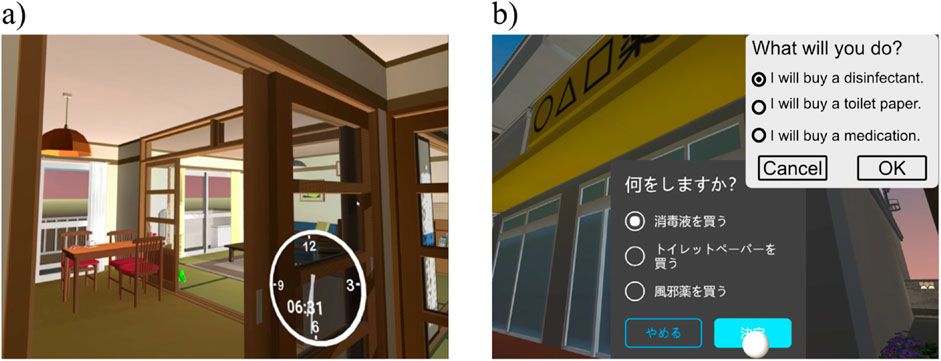
Figure 2. White clock for monitoring time (left) and a user interface on which participants select their answer (right).
Participants navigated between the home and shopping street, which are two typical daily-life settings in Japan, using the joystick of the handheld controllers. They referred to the on-screen clock to identify appropriate times for PM tasks and walked through the VR environment to reach the relevant objects. Executing a task involved moving through the VR environment and interacting with objects related to the task, triggering a dialog box with a button to confirm task completion. During the VRT phase, the participants completed both simple execution tasks and tasks requiring the selection of the correct action among multiple options. Walking through and executing a task are performed by the controller.
Participants performed specified tasks within the accelerated time flow. The tasks were presented at the beginning of each VRT session. Regular tasks remained constant across all sessions, whereas irregular tasks varied from session to session. Each task was categorized as event-based (expected to be triggered by an event) or time-based (expected to be executed within a specified time window). Event-based tasks were judged solely on completion, whereas time-based tasks were evaluated on both completion and timing accuracy. The acceptable window was bounded by 15 virtual minutes before and 10 virtual minutes after the designated time.
Inspired by the Virtual Week task structure, the VRT phase included 10 p.m. tasks per day: five regular tasks (two time-based and three event-based) and up to five irregular tasks (three time-based and two event-based). This structure was designed to challenge participants with lower PM abilities (such as older adults) while being achievable by those with higher PM capabilities (such as university students). Considering the time required to navigate between the most distant points in the VR environment and perform the PM tasks, the task interval was set to one virtual hour (3 minutes in real time).
The VR environment included 11 objects in the home and six objects in the shopping street for executing PM tasks. During the tutorial, participants watched a video and practiced regular tasks to familiarize themselves with the VR environment and the task-execution process. Figure 1 shows the two virtual environments, namely, a home (10 m
The study also implemented two distractor tasks: a whack-a-mole game played in the home environment and a shooting gallery game played in the shopping street. Participants engaged in these background tasks until the optimal time of recall to execute their PM tasks. At the appropriate time, the participants moved to the designated location of the PM tasks within the VR environment.
2.3 Experiment
This experiment aimed to evaluate the effectiveness and usability of the VIT and VRT components of the VR–PMT system. The study ensured that all procedures adhered to the ethical guidelines of research involving human participants and was approved by the ethics committee of Kyoto University, Japan. Participants were provided a thorough explanation—both verbally and in writing—regarding the purpose of this study, involved methods, its requirements, potential benefits and risks, and their rights to voluntary participation and withdrawal at any time. Written informed consent was then obtained from all participants. This study ensured the protection of participants’ privacy and personal information by anonymizing data during their handling.
To assess the effectiveness of the system across different age groups, both university students and older adults were recruited for the study. The participants were 10 healthy adults: five university students (mean age 22.4
To determine whether our PM tasks truly reflect PM ability and to confirm the necessity of imagery, we computed the Pearson product-moment correlation coefficients. Significant correlations between task performance and MIST scores would indicate that the tasks effectively measure the participants’ PM abilities. The correlation between task achievement and visual imagery checks whether our PM tasks are influenced by imagery abilities, emphasizing the need for imagery strategies. Meanwhile, significant correlations between task performance and imagery task achievement would support the importance of incorporating imagery strategies into PM training. To evaluate the design for difficulty progression, the task achievement rates of all participants in each session were determined. If the task completion rate does not decline in the latter half of the session, then it supports the appropriateness of the proposed design for difficulty progression. Usability evaluation is a crucial components of system assessment. Subjective fatigue was assessed on the Jikaku-sho Shirabe questionnaire, which focuses on work-related feelings of fatigue (Sasaki and Matsumoto, 2005; Kubo et al., 2011). The questionnaire comprises 25 subjective expressions in five categories: drowsiness, instability, uneasiness, dullness, and eyestrain. The participants rated the intensities of their feelings on a five-point Likert scale, ranging from “totally disagree” to “strongly agree,” for each item. Scores of 1, 2, 3, 4, and 5 were assigned to intensity levels of 1, 2, 3, 4, and 5, respectively. To assess the effect of age on fatigue during the VR training sessions, we compared the levels of reported fatigue between elderly and young participants across the five factors.
The task-related user experience was assessed on the user experience questionnaire (UEQ) (Laugwitz et al., 2008; Schrepp et al., 2014; Schrepp et al., 2017a). This study employed the short version of the UEQ (UEQ-S), which includes eight items related to efficiency, perspicuity, dependability, stimulation, and novelty (Schrepp et al., 2017b). Participants rated their feelings for each item on a scale from −3 (most negative) to +3 (most positive). To analyze the users’ experience, the differences in ratings between elderly and young participants were compared to assess the perceived usability and enjoyment of the two groups.
3 Result
3.1 Validation for the integration of visual imagery and daily-life simulations
The scatter plots presented in Figure 3 show the correlations between task achievement as well as MIST scores and imagery task achievement across different task categories. The plots also include regression lines with corresponding equations to show the linear relationships in each case. Additionally, the top-left plot demonstrates a positive correlation between overall task achievement and MIST scores, indicating an association between higher MIST scores and higher task achievement. Similarly, the top-right plot shows a strong correlation between overall task and imagery task achievements. The middle row displays separate regression lines for regular and irregular tasks. Regular tasks exhibit a steeper slope than irregular tasks, indicating different trends in their relationships. The bottom row compares time- and event-based tasks, where the regression lines for time-based tasks show steeper slopes than those for event-based tasks. As shown in Table 3, the MIST scores and imagery abilities were significantly correlated with task achievement across various task types. Each row presents the correlation coefficients
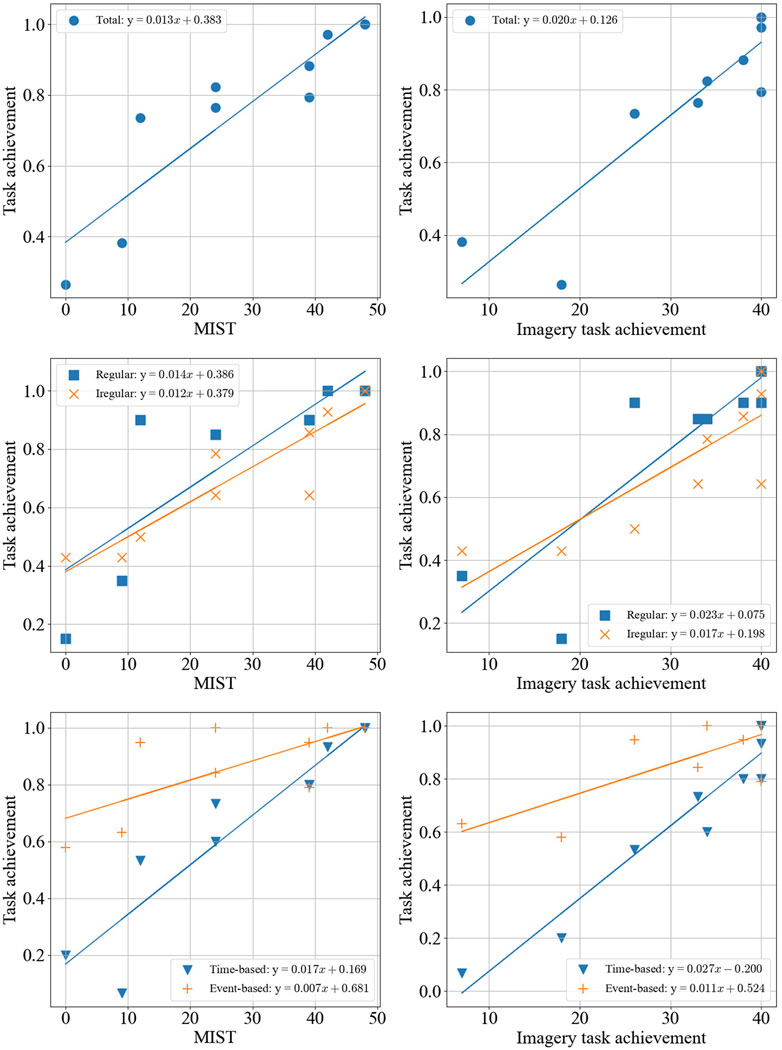
Figure 3. Correlation analyses of total task achievement (top), achievements for regular and irregular tasks (center), and achievements for time-based and event-based tasks (bottom) vs MIST and imagery abilities.
Figure 4 visually compares the task achievements across the different task types. The box plots indicate that participants achieved higher scores in event-based tasks than in time-based tasks. They also obtained higher scores in regular tasks than in irregular tasks. This visual representation reinforces the statistical findings, highlighting the significant differences in task achievement based on task type and regularity.
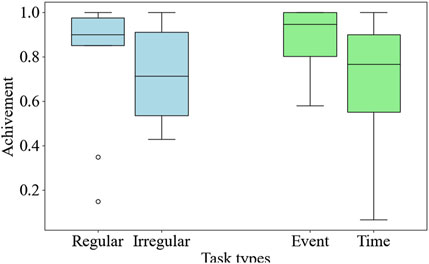
Figure 4. Comparison of task achievements across regular, irregular, event-based, and time-based tasks.
Table 4 shows the task achievement rates for all participants across VRT sessions 5–8. The achievement rates for the elderly group (uppercase letters) were generally lower compared with those for the younger group (lowercase letters). A consistent decrease in the achievement rate was not observed across any participant groups.
The UEQ-S results (Figure 5) demonstrate that both elderly and young participants rated the system positively across various satisfaction factors. However, the elderly participants perceived the system as less “Leading edge,” “Inventive,” and “Interesting” than younger participants. The system was rated as “Exciting” and “Clear” by the younger participants, “Efficient” and “Easy” by both groups (with young participants providing higher scores than their elderly counterparts), and “Supportive” by both groups. The low scores of “Complicated,” “Confusing,” and “Obstructive” across both groups indicate that the system is perceived as non-complex and reasonably easy to use.
The results (Figure 6) of the Jikaku-sho Shirabe questionnaire highlight varying levels of fatigue between the elderly and young participants. The elderly participants reported higher scores for eyestrain, dullness, uneasiness, instability, and drowsiness than younger participants, indicating that elderly individuals were more fatigued by VR training then the younger participants.
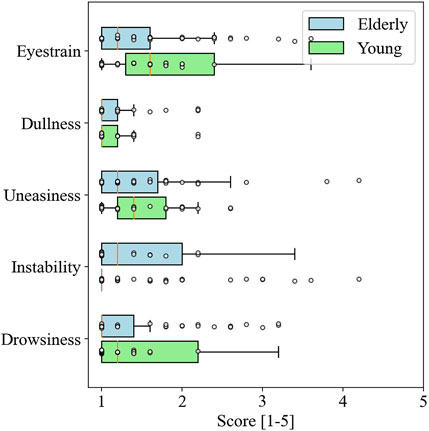
Figure 6. Comparison of subjective fatigue levels (Jikaku-sho Shirabe) between the elderly and young participants.
3.2 Post-hoc analysis: why is the correlation coefficient the lowest in event-based tasks?
The timing of execution for event-based tasks is the primary focus of this study; event-based tasks exhibit distinct characteristics compared with other task types. This timing of execution is not linked to a specific time; thus, a participant can execute the task based on their preference. We hypothesize that this unique feature contributes to the lower correlation coefficient and wider confidence interval in event-based tasks compared with those in other task types.
Before conducting the post hoc analysis to investigate the reasons for the lowest correlation coefficient in event-based tasks, all event-based tasks designed in the study were overviewed (Table 5). Each task was identified by a unique ID for analysis, along with a description of the required action and the time-remembered task (TRT). The TRT indicates the duration at which the participants are expected to memorize the tasks. In the TRT column, “Before” indicates that the tasks were presented at the beginning of the VRT session, while specific times (e.g., 10:00 or 12:00) indicate that new tasks appeared at those designated times during the VRT session.
Table 6 shows the duration from when participants remembered a task to when they executed it for event-based tasks. It also shows the normalized values derived using the min–max method, enabling comparisons across different task types. The numeric values in each cell represent the time taken from remembering to executing a task, and the numbers within parentheses denote the corresponding normalized values in the one task. The table also distinguishes between elderly participants (denoted by uppercase letters) and younger participants (denoted by lowercase letters). The normalized values (Table 6) show that participants B, c, and e frequently executed tasks much sooner than other participants; they completed four or more tasks in less than 20% of the time taken by the slowest participant for the same task. Additionally, tasks ER4 and ER6 introduced in the middle of the VRT were shorter than other tasks.
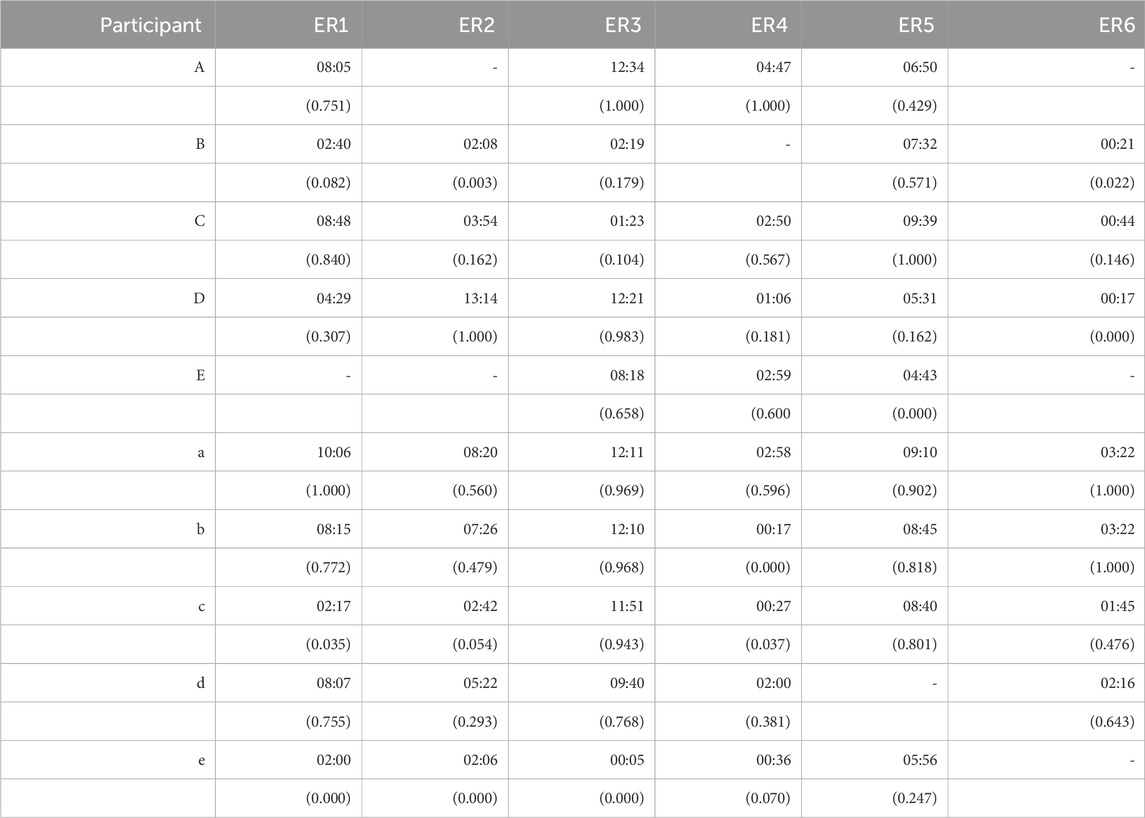
Table 6. Duration from remembering the task to its execution and its normalized value obtained using the min–max method for each event-based task.
4 Discussion
As revealed in the scatter plots (Figure 3), our VR training system accurately reflects the PM capabilities of the participants. Specifically, individuals with higher MIST scores and better imagery task performance achieved higher task completion rates in the VRT tasks than those with lower scores. Further analysis of the results shows that the VR training system effectively differentiates participants with varying PM abilities. Moreover, the correlation between MIST scores and task achievement rates suggests that the system can reliably assess PM capabilities. The implementation of visual imagery strategies within the VR environment appears to enhance task performance, as indicated by the positive relationship between imagery task achievement and overall task performance. Besides providing a realistic training scenario, the integration of visual imagery strategies within the VR environment leverages the strengths of both VR and imagery-based approaches to enhance the training outcomes. These findings suggest that the proposed VR–PMT has the potential to assess PM capabilities. The structure of the training program helps users to gradually build their confidence and skills, enabling adaptation to more challenging tasks over time. Figure 4 shows that the proposed task implementation in VRT was well designed, indicating that time-based tasks are more difficult to undertake than event-based tasks. Moreover, irregular tasks were more difficult to undertake than regular ones. The findings are also consistent with those reported by Rendell and Craik (2000b), which revealed that the user performance on irregular tasks was lower than on regular tasks. This confirmed the consistency of our design intention with task difficulty. The difficulty structure in the progression of training program began with simple tasks (regular and event-based) and progresses to more complex tasks (irregular and time-based) as the sessions proceed. Table 4 indicates that there were no significant decrements in task achievement rates across sessions and that the difficulty progression in the training design was generally appropriate. The rate of task achievements varied more among elderly participants than among young participants. However, for most participants, including younger and older ones, the task achievement rates remained relatively stable, even when the difficulty level increased. This stability indicates that the gradual increase in complexity did not destabilize the user performance and allowed them to maintain consistent performance throughout. The absence of significant decrements in task completion rates, particularly in the latter sessions, supports the effectiveness of the training design, which aimed to progressively increase the task difficulty.
The proposed framework effectively simulated realistic situations, allowing participants to execute some tasks according to their own strategies (Table 6). Table 6 shows that some participants (B, c, and e) tended to complete their tasks as quickly as possible because they executed the tasks immediately after remembering them. This tendency likely contributed to higher PM achievement rates. Thus, whether the event-based tasks in this framework contribute to the improvement of PM abilities requires further analysis. However, the framework effectively learns how to execute planned actions. If the planned actions are independent of other tasks or specific times, then completing them as early as possible is a reasonable behavior in everyday life for training aimed at achieving daily goals. Therefore, the framework enables participants to recognize their own capabilities and learn practical strategies for early execution of tasks. Acquiring such strategies is useful during the course of training, as it allows participants to develop strategies suited to their abilities.
The unique timing characteristics of event-based tasks were studied to determine the difference in correlation patterns compared with those of other task types. Unlike that for time-based tasks, the execution timing for event-based tasks is flexible. This may account for the observed lower correlation coefficients, wider confidence intervals, and flatter regression slopes in Figure 3. The flexibility in timing allows participants to employ various strategies for executing tasks. For instance, the normalized values in Table 6 show that participants B, c, and e often executed tasks shortly after remembering them. This immediate execution suggests a strategy for minimizing the load toward PM by quickly completing tasks for avoiding the possibility of forgetting them. Such an approach can reduce the participants’ dependency on PM abilities because they may not need to retain task information for longer durations and instead reinforce task recall through rapid memory rehearsal. This strategy explains the weaker relationship between PM scores and task achievement for event-based tasks. By executing tasks immediately, participants effectively reduce the influence of their underlying PM capabilities on task performance. Consequently, the variability in PM abilities among participants does not manifest as distinctly in their task achievement, which is clearly reflected in the flatter regression slopes and weaker correlations.
Whether event-based tasks in the proposed framework improve the PM abilities requires further investigation. For effective training, the design for event-based task should be improved to enhance its influence on PM ability and better simulate real-world complexities. This will prevent participants from executing tasks immediately after remembering them. One potential improvement is presenting an event-based task to participants shortly before they are scheduled to perform a time-based task. As the time-based task has a fixed execution time, participants must prioritize completing it first, delaying the execution of the event-based task. However, the framework is effective in terms of learning how to execute planned actions. For training aimed at achieving daily goals, if the planned actions are independent of other tasks or specific times, then completing them as early as possible is a reasonable behavior in everyday life. Therefore, the framework enables participants to recognize their own capabilities and learn practical strategies for executing tasks earlier. Acquiring such strategies is useful during the course of training as it allows participants to develop strategies suited to their individual abilities. The VR–PMT platform was considered as innovative and engaging by both age groups (Figure 5). The higher ratings of “Exciting” and “Clear” by younger participants indicate that these participants found the system more stimulating and understandable than the elderly participants. The similarly high ratings of “Supportive” by both age groups suggest that the system effectively aids users in completing their tasks. The low scores of “Complicated,” “Confusing,” and “Obstructive” indicate the user-friendliness and relative simplicity of the system.
As indicated in Figure 6, the VR–PMT platform can potentially provide a stimulating and engaging training environment while pinpointing areas that should be improved to enhance user comfort and reduce fatigue. The elevated eyestrain scores suggest that VR imposes a high visual demand, potentially enhancing the sense of immersion and focus of elderly users. The higher dullness and uneasiness scores might reflect the intense cognitive engagement required by VR training, indicating that the system effectively stimulates mental activity. The increased instability and drowsiness scores of the elderly participants than of the younger participants highlight the need for tailored interventions, such as regular breaks and ergonomic adjustments, to optimize the training experience of older users.
Despite being a preliminary study with a limited sample size, this study can contribute to VR-based PM training. Moreover, this study primarily introduced a more detailed framework for task design and implementation compared with those reported in previous studies, providing in-depth guidance for developing a VR-based PM training system. The task structures were outlined, and the framework design was validated. The task achievement rates reflected the PM abilities of participants that were consistent with the findings from existing literature. Although the confidence intervals for correlation coefficients were relatively narrow, which supported the reliability of the observed relationships across most task types, event-based tasks demonstrated a different pattern. This distinct trend was thoroughly examined by analyzing the task-execution timing in detail. Results provided insights into the participants’ strategies that had not been previously reported in studies related to VR-based PM training. By addressing this variability, we provided a novel understanding of the influence of execution timing on the PM task performance and laid the groundwork for future improvements in training design. The correlations between task achievement as well as the MIST scores and imagery performance suggest that the VR-PMT system reflects PM capabilities; however, other factors may also influence outcomes. Task similarity to participants’ daily life, familiarity with digital interfaces, or individual motivation can contribute to participant performance. Future studies should consider broader cognitive assessments to better isolate the effects of PM and imagery abilities. Given the simplicity of the proposed VR environment and tasks, future research should also investigate the effectiveness of the proposed framework in more complex and dynamic scenarios.
Data availability statement
The dataset is proprietary and restricted to use within the research team or institution due to ethical and legal considerations. It is not available for external sharing. Requests to access the datasets should be directed to ZnVrdW1vcmkuc2F0b3NoaUBrYWdhd2EtdS5hYy5qcA==.
Ethics statement
The studies involving humans were approved by Kyoto University Graduate School and Faculty of Medicine, Ethics Committee. The studies were conducted in accordance with the local legislation and institutional requirements. The participants provided their written informed consent to participate in this study.
Author contributions
SF: Writing – original draft, Writing – review and editing, Funding acquisition, Methodology, Software, Investigation. KM: Writing – original draft, Writing – review and editing, Methodology, Funding acquisition, Investigation. AT: Writing – original draft, Writing – review and editing, Formal Analysis. SO: Writing – original draft, Writing – review and editing, Funding acquisition, Investigation.
Funding
The author(s) declare that financial support was received for the research and/or publication of this article. This work was supported in part by the JSPS KAKENHI Grant Number 20H01776.
Conflict of interest
The authors declare that the research was conducted in the absence of any commercial or financial relationships that could be construed as a potential conflict of interest.
Generative AI statement
The author(s) declare that no Generative AI was used in the creation of this manuscript.
Publisher’s note
All claims expressed in this article are solely those of the authors and do not necessarily represent those of their affiliated organizations, or those of the publisher, the editors and the reviewers. Any product that may be evaluated in this article, or claim that may be made by its manufacturer, is not guaranteed or endorsed by the publisher.
Supplementary material
The Supplementary Material for this article can be found online at: https://www.frontiersin.org/articles/10.3389/frvir.2025.1555111/full#supplementary-material
References
Berg, E. v. d., Kant, N., and Postma, A. (2012). Remember to buy milk on the way home! a meta-analytic review of prospective memory in mild cognitive impairment and dementia J Int Neuropsychol Soc, 18, 706–716. doi:10.1017/S1355617712000331
Brooks, B. M., Rose, F. D., Potter, J., Jayawardena, S., and Morling, A. (2004). Assessing stroke patients’ prospective memory using virtual reality. Brain Inj. 18, 391–401. doi:10.1080/02699050310001619855
Guajardo, N. R., and Best, D. L. (2000). Do preschoolers remember what to do? incentive and external cues in prospective memory. Cogn. Dev. 15, 75–97. doi:10.1016/S0885-2014(00)00016-2
Henry, J. D., MacLeod, M. S., Phillips, L. H., and Crawford, J. R. (2004). A meta-analytic review of prospective memory and aging. Psychol. Aging 19, 27–39. doi:10.1037/0882-7974.19.1.27
Hering, A., Rendell, P. G., Rose, N. S., Schnitzspahn, K. M., and Kliegel, M. (2014). Prospective memory training in older adults and its relevance for successful aging. aging 78, 892–904. doi:10.1007/s00426-014-0566-4
Hicks, J. L., Marsh, R. L., and Cook, G. I. (2005). Task interference in time-based, event-based, and dual intention prospective memory conditions☆. J. Mem. Lang. 53, 430–444. doi:10.1016/j.jml.2005.04.001
Hogan, C., Cornwell, P., Fleming, J., Man, D. W. K., and Shum, D. H. K. (2023). Assessment of prospective memory after stroke utilizing virtual reality. Virtual Real. 27, 333–346. doi:10.1007/s10055-021-00576-5
Huang, D., Yan, S., Shen, S., Lv, S., Lai, S., Zhong, S., et al. (2022). Effects of virtual reality working memory training on event-based prospective memory in patients with major depressive disorder. J. Psychiatr. Res. 156, 91–99. doi:10.1016/j.jpsychires.2022.09.049
Jones, W. E., Benge, J. F., and Scullin, M. K. (2021). Preserving prospective memory in daily life: a systematic review and meta-analysis of mnemonic strategy, cognitive training, external memory aid, and combination interventions. Comb. interventions 35, 123–140. doi:10.1037/neu0000704
Kliegel, M., Martin, M., McDaniel, M. A., and Einstein, G. O. (2001). Varying the importance of a prospective memory task: differential effects across time - and event-based prospective memory. Memory 9, 1–11. doi:10.1080/09658210042000003
Knight, R. G., and Titov, N. (2009). Use of virtual reality tasks to assess prospective memory: applicability and evidence. Brain Impairment, 10, 3–13. doi:10.1375/brim.10.1.3
Koo, Y. W., Neumann, D. L., Ownsworth, T., and Shum, D. H. K. (2021). Revisiting the age-prospective memory paradox using laboratory and ecological tasks. Front. Psychol. 12. doi:10.3389/fpsyg.2021.691752
Kourtesis, P., Collina, S., Doumas, L. A. A., and MacPherson, S. E. (2021). Validation of the virtual reality everyday assessment lab (VR-EAL): an immersive virtual reality neuropsychological battery with enhanced ecological validity. J. Int. Neuropsychol. Soc. 27, 181–196. doi:10.1017/S1355617720000764
Kourtesis, P., Korre, D., Collina, S., Doumas, L. A. A., and MacPherson, S. E. (2020). Guidelines for the development of immersive virtual reality software for cognitive neuroscience and neuropsychology: the development of virtual reality everyday assessment lab (VR-EAL), a neuropsychological test battery in immersive virtual reality. Front. Comput. Sci. 1. doi:10.3389/fcomp.2019.00012
Kubo, T., Takahashi, M., Sato, T., Sasaki, T., Oka, T., and Iwasaki, K. (2011). Weekend sleep intervention for workers with habitually short sleep periods. Scand. J. Work Environ. Health 37, 418–426. doi:10.5271/sjweh.3162
Kvavilashvili, L., Kornbrot, D. E., Mash, V., Cockburn, J., and Milne, A. (2009). Differential effects of age on prospective and retrospective memory tasks in young, young-old, and old-old adults. young-old, old-old adults 17, 180–196. doi:10.1080/09658210802194366
Laugwitz, B., Held, T., and Schrepp, M. (2008). “Construction and evaluation of a user experience questionnaire,” in HCI and usability for education and work. Editor A. Holzinger (Springer, Lecture Notes in Computer Science), 63–76. doi:10.1007/978-3-540-89350-9_6
Martin, M., Kliegel, M., and McDaniel, M. A. (2003). The involvement of executive functions in prospective memory performance of adults. Int. J. Psychol. 38, 195–206. doi:10.1080/00207590344000123
Mathews, M., Mitrovic, A., Ohlsson, S., Holland, J., and McKinley, A. (2016). A virtual reality environment for rehabilitation of prospective memory in stroke patients. Procedia Comput. Sci. 96, 7–15. doi:10.1016/j.procs.2016.08.081
Mioni, G., Rendell, P. G., Terrett, G., and Stablum, F. (2015). Prospective memory performance in traumatic brain injury patients: a study of implementation intentions. J. Int. Neuropsychol. Soc. 21, 305–313. doi:10.1017/S1355617715000211
Miura, K., Adachi, K., and Koike, A. (2008). Effects of memorization strategies and imagery control ability on miyake paired-associate word learning test. Jpn. J. Neuropsychol. 24, 275–281.
Park, D. C., Hertzog, C., Kidder, D. P., Morrell, R. W., and Mayhorn, C. B. (1997). Effect of age on event-based and time-based prospective memory. Psychol. Aging 12, 314–327. doi:10.1037//0882-7974.12.2.314
Radford, K. A., Lah, S., Say, M. J., and Miller, L. A. (2011). Validation of a new measure of prospective memory: the royal prince alfred prospective memory test. Clin. Neuropsychol. 25, 127–140. doi:10.1080/13854046.2010.529463
Raskin, S. A., Buckheit, C., and Sherrod, C. (2010). Memory for Intentions Screening Test (MIST). APA PsycTests. doi:10.1037/t74479-000
Raskin, S. A., Smith, M. P., Mills, G., Pedro, C., and Zamroziewicz, M. (2019). Prospective memory intervention using visual imagery in individuals with brain injury. Brain Inj. 29, 289–304. doi:10.1080/09602011.2017.1294082
Raskin, S. A., Williams, J., and Aiken, E. M. (2020). “A review of prospective memory in individuals with acquired brain injury,” in Prospective memory in clinical populations. Routledge/Taylor and Francis Group.
Rendell, P. G., and Craik, F. I. M. (2000a). Virtual week and actual week: age-related differences in prospective memory. Appl. Cogn. Psychol. 14, S43–S62. doi:10.1002/acp.770
Rendell, P. G., and Craik, F. I. M. (2000b). Virtual week and actual week: age-related differences in prospective memory. Appl. Cogn. Psychol. 14, S43–S62. doi:10.1002/acp.770
Rendell, P. G., and Henry, J. D. (2009). A review of virtual week for prospective memory assessment: clinical implications 10, 14–22. doi:10.1375/brim.10.1.14
Rose, N. S., Rendell, P. G., McDaniel, M. A., Aberle, I., and Kliegel, M. (2010). Age and individual differences in prospective memory during a Virtual Week: the roles of working memory, vigilance, task regularity, and cue focality. vigilance, task Regul. cue focality 25, 595–605. doi:10.1037/a0019771
Rus-Calafell, M., Garety, P., Sason, E., Craig, T. J. K., and Valmaggia, L. R. (2018). Virtual reality in the assessment and treatment of psychosis: a systematic review of its utility, acceptability and effectiveness. Accept. Eff. 48, 362–391. doi:10.1017/S0033291717001945
Sasaki, T., and Matsumoto, S. (2005). Actual conditions of work, fatigue and sleep in non-employed, home-based female information technology workers with preschool children. children 43, 142–150. doi:10.2486/indhealth.43.142
Schrepp, M., Hinderks, A., and Thomaschewski, J. (2014). “Applying the user experience questionnaire (UEQ) in different evaluation scenarios,” in design, user experience, and usability. Editors A. Marcus Theories, methods, and tools for designing the user experience. Cham: Springer International Publishing, 383–392. doi:10.1007/978-3-319-07668-3_37
Schrepp, M., Hinderks, A., and Thomaschewski, J. (2017a). Construction of a benchmark for the user experience questionnaire (UEQ). UEQ 4, 40–44. doi:10.9781/ijimai.2017.445
Schrepp, M., Hinderks, A., and Thomaschewski, J. (2017b). Design and evaluation of a short version of the user experience questionnaire (UEQ-S). International Journal of Interactive Multimedia and Artificial Intelligence, 4, 103. doi:10.9781/ijimai.2017.09.001
Shelton, J. T., Lee, J. H., Scullin, M. K., Rose, N. S., Rendell, P. G., and McDaniel, M. A. (2016). Improving prospective memory in healthy older adults and individuals with very mild alzheimer's disease. J. Am. Geriatr. Soc. 64, 1307–1312. doi:10.1111/jgs.14134
Sheppard, D. P., Matchanova, A., Sullivan, K. L., Kazimi, S. I., and Woods, S. P. (2020). Prospective memory partially mediates the association between aging and everyday functioning. Clin. Neuropsychol. 34, 755–774. doi:10.1080/13854046.2019.1637461
Shum, D., Fleming, J., and Neulinger, K. (2002). Prospective memory and traumatic brain injury: a review. A Rev. 3, 1–16. doi:10.1375/brim.3.1.1
Sohlberg, M. M., Ehlhardt, L., and Kennedy, M. (2005). Instructional techniques in cognitive rehabilitation: a preliminary report. Semin. Speech Lang. 26, 268–279. doi:10.1055/s-2005-922105
Umeda, S., Nagumo, Y., and Kato, M. (2006). Dissociative contributions of medial temporal and frontal regions to prospective remembering. Rev. Neurosci. 17, 267–278. doi:10.1515/revneuro.2006.17.1-2.267
Valmaggia, L. R., Latif, L., Kempton, M. J., and Rus-Calafell, M. (2016). Virtual reality in the psychological treatment for mental health problems: an systematic review of recent evidence. Psychiatry Res. 236, 189–195. doi:10.1016/j.psychres.2016.01.015
Wang, Y., Cui, J., Chan, R. C. K., Deng, Y., Shi, H., Hong, X., et al. (2009). Meta-analysis of prospective memory in schizophrenia: nature, extent, and correlates. Nat. extent, Correl. 114, 64–70. doi:10.1016/j.schres.2009.07.009
Wilson, B., Emslie, H., Foley, J., Shiel, A., Watson, P., Hawkins, K., et al. (2005). Cambridge test of prospective memory kit. Psychological Corporation Ltd.
Woods, S. P., Weinborn, M., Li, Y. R., Hodgson, E., Ng, A. R., and Bucks, R. S. (2015). Does prospective memory influence quality of life in community-dwelling older adults? Neuropsychol Dev Cogn B Aging Neuropsychol Cogn, 22, 679–692. doi:10.1080/13825585.2015.1027651
Woods, S. P., Weinborn, M., Maxwell, B. R., Gummery, A., Mo, K., Ng, A. R., et al. (2014). Event-based prospective memory is independently associated with self-report of medication management in older adults. Aging Ment. Health 18, 745–753. doi:10.1080/13607863.2013.875126
Woods, S. P., Weinborn, M., Velnoweth, A., Rooney, A., and Bucks, R. S. (2012). Memory for intentions is uniquely associated with instrumental activities of daily living in healthy older adults. J. Int. Neuropsychol. Soc. 18, 134–138. doi:10.1017/S1355617711001263
Yip, B. C. B., and Man, D. W. K. (2013). Virtual reality-based prospective memory training program for people with acquired brain injury. Brain Inj. 32, 103–115. doi:10.3233/NRE-130827
Zogg, J. B., Woods, S. P., Sauceda, J. A., Wiebe, J. S., and Simoni, J. M. (2012). The role of prospective memory in medication adherence: a review of an emerging literature. J. Behav. Med. 35, 47–62. doi:10.1007/s10865-011-9341-9
Keywords: prospective memory, virtual reality, cognitive training, visual imagery, framework and architecture
Citation: Fukumori S, Miura K, Takamori A and Otsuka S (2025) Designing a virtual reality framework for prospective memory training: integration of visual imagery and daily-life simulations. Front. Virtual Real. 6:1555111. doi: 10.3389/frvir.2025.1555111
Received: 03 January 2025; Accepted: 23 April 2025;
Published: 13 May 2025.
Edited by:
David Joseph Brown, Nottingham Trent University, United KingdomReviewed by:
Pietro Neroni, National Research Council (CNR), ItalyEleni Baldimtsi, Aristotle University of Thessaloniki, Greece
Copyright © 2025 Fukumori, Miura, Takamori and Otsuka. This is an open-access article distributed under the terms of the Creative Commons Attribution License (CC BY). The use, distribution or reproduction in other forums is permitted, provided the original author(s) and the copyright owner(s) are credited and that the original publication in this journal is cited, in accordance with accepted academic practice. No use, distribution or reproduction is permitted which does not comply with these terms.
*Correspondence: Satoshi Fukumori, ZnVrdW1vcmkuc2F0b3NoaUBrYWdhd2EtdS5hYy5qcA==
 Satoshi Fukumori
Satoshi Fukumori Kayoko Miura
Kayoko Miura Ayako Takamori
Ayako Takamori Sadao Otsuka
Sadao Otsuka